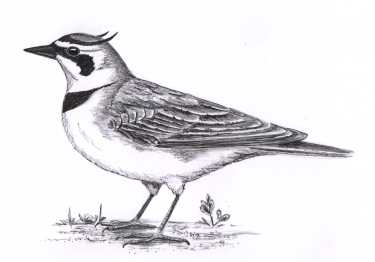
Dear Bird Folks:
What do you know about horned larks? All fall I have been seeing these cool birds near first Encounter Beach in Eastham. Since that is such a nasty place in the winter, will they eventually head south?
Jack, Eastham
First of all Jack,
As far as I’m concerned, First Encounter Beach is a wonderful place in the winter. The summer is when it is a nasty place to be. In the summer it is hot, sticky, crowded and full of fat guys in Speedos. And let’s not forget the no-see-ums, the greenhead flies, and the fat guys in Speedos. In the winter the beach is refreshing, active with bird life and, except for an endless stream of pooping dogs, much quieter.
Aside from that minor disagreement, I totally agree with you, horned larks are cool birds. And like many birds we seem to be talking about lately, many of us didn’t realize that larks existed around here, yet they are locally common and easy to find. Horned larks are North America’s only native lark. Everyone knows that larks are birds, but that’s about all most people know about them. We use the expression “happy as a lark,” but do we really know if larks are happy? Then there is the saying, “I did it for a lark.” I don’t even want to guess what that’s all about. Sounds a bit sketchy to me.
You might be thinking, if horned larks are our only larks, what about meadowlarks? Arne’t they larks? The answer is nope, they are not larks. The name meadowlark is one word. There is no species of lark called meadow lark. A meadowlark is another kind of bird all together. Meadowlarks are related to blackbirds and orioles and have little to do with real larks.
Horned larks are handsome, well-marked birds that are fairly easy to identify. They like open, treeless areas to nest or to winter in. Acting much like sparrows, they sneak about through the grasses looking for seeds to eat. Horned larks aren’t as secretive as sparrows and have no problem being seen in the open. Since larks live in open areas and don’t have access to high perches in which to sing and announce their territories, they have developed a creative and elaborate “flight song.” During the breeding season a male lark will fly straight up to 800 feet and then fly in a big circle, while singing, to announce his territory. Then, without warning, the lark will dive like an arrow, back toward the ground. The plummeting lark appears ready to strike the earth at full speed, but suddenly opens its wings at the very last moment and is able to avoid total embarrassment.
Horned larks are often referred to as “prarie larks” for they were once more commonly seen in the western prairies. Larks were one of the few creatures that were thrilled when the Europeans clear cut most of eastern North America. They quickly spread east and thrived where the trees have returned and the larks have moved out. Large flocks of this handsome bird can be seen in its western range during the winter, moving about searching for food. Here on Cape Cod, First Encounter Beach is a great place to see them anytime of the year. Larks nest there in the summer. Larks can also be seen there toughing it out in the winter, although they probably aren’t the same birds.
So Jack, anytime of year is a good time to look for these wonderful little larks and First Encounter is the place to go. However, if you look for them in the summer, be careful where you focus your binoculars. Seeing a fat guy in a Speedo through binoculars could scar you for life.